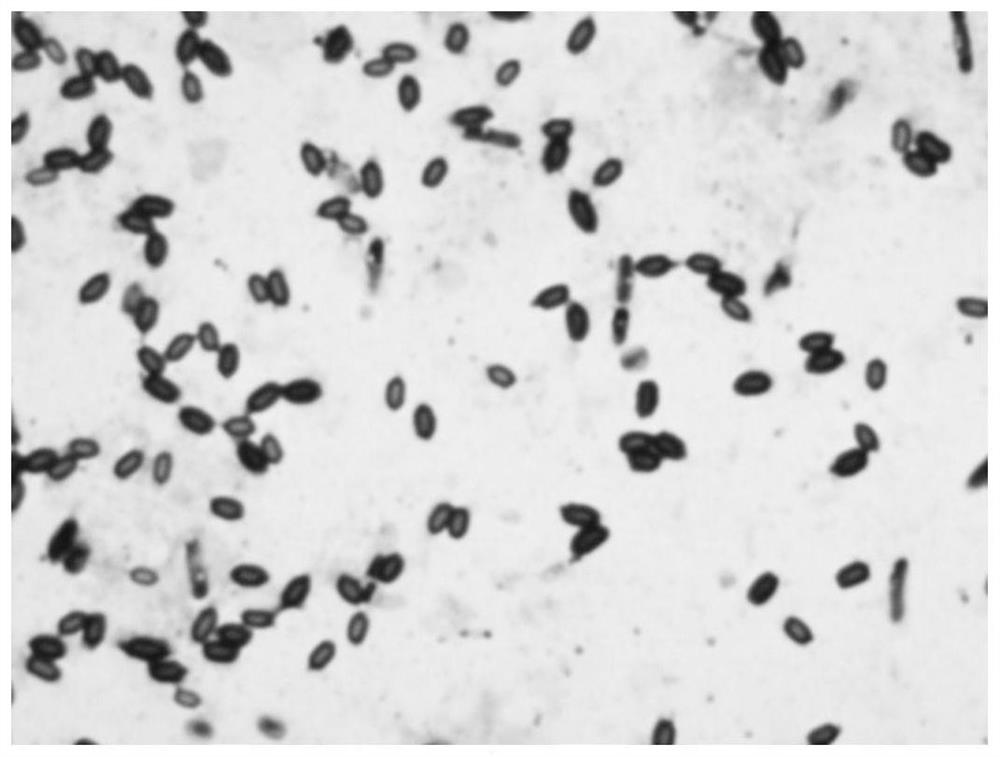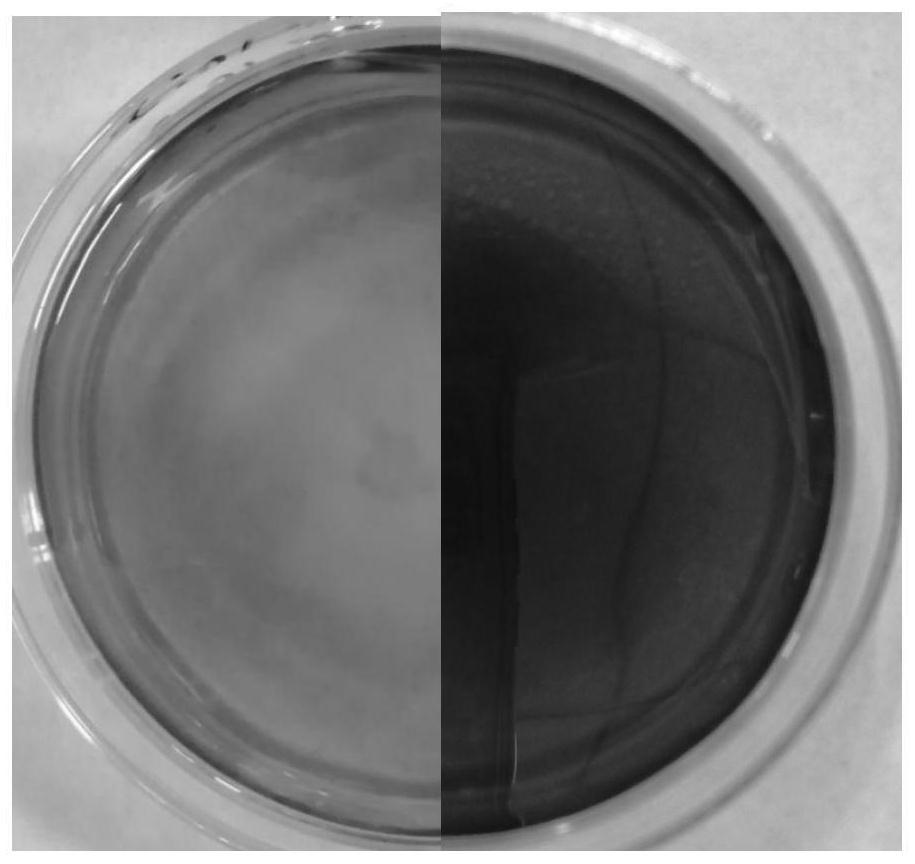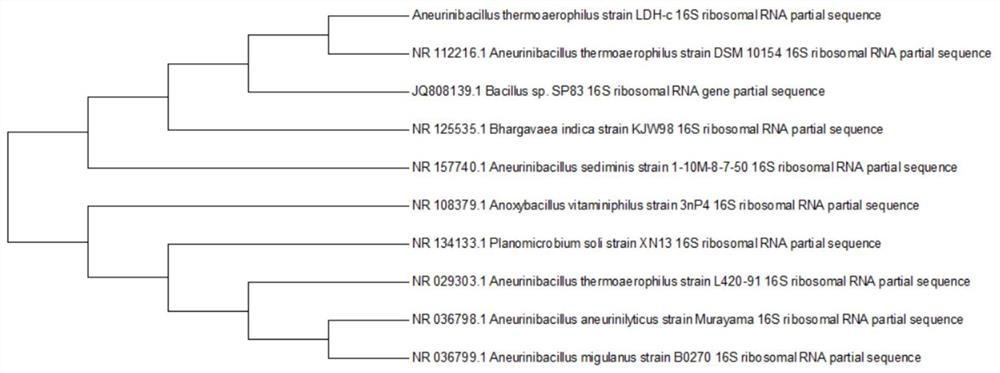Thermophilic aerophilic thiamine-decomposing bacillus, microbial inoculum and application of microbial inoculum
A bacillus and sulfur-resolving technology, applied in the field of microorganisms, can solve problems such as low decomposition efficiency
- Summary
- Abstract
- Description
- Claims
- Application Information
AI Technical Summary
Problems solved by technology
Method used
Image
Examples
Embodiment 1
[0032] Embodiment 1: the isolation culture of soil microorganism LDH-C
[0033] 1. Sample collection: In June 2018, I went to Yichun City, Heilongjiang Province, and took soil samples within 20cm of forest rotting wood. I took soil samples from the surface layer, 5cm and 10cm depths, and collected the soil with a sealed bag. After the collection, I used it in the experiment The three soil samples were mixed indoors, and the mixed soil samples were divided into three parts, which were used as three replicates. After being quick-frozen in liquid nitrogen, they were stored in a -80°C refrigerator for later use.
[0034] 2. Soil enrichment and separation
[0035] Accurately weigh 1g of the mixed soil sample, put it into a 250ml Erlenmeyer flask filled with 100ml of double distilled water, put it into a shaker, shake it at 120rpm / min for 30 minutes, let it stand for 1 hour, and take the supernatant according to 10% of the inoculum was inoculated in the MSM medium with guaiacol (1m...
Embodiment 2
[0042] The 16SrDNA sequence analysis of embodiment 2LDH-C
[0043] The strain LDH-C was sent to Shanghai Passino Biotechnology Co., Ltd. for 16SrDNA sequencing analysis, so as to identify the strain.
[0044] Bacterial species identification results: Blast sequence comparison of the sequenced strains on NCBI showed that the sequence similarity between strain LDH-C and Aneurinibacillus thermoaerophilus strain DSM 10154 was 99.86%, and the strain LDH could be identified accordingly -C belongs to Aneurinibacillusthermoaerophilus in molecular phylogenetic taxonomy.
[0045] The 16SrDNA sequence of strain LDH-C is shown in SEQ ID NO.1, image 3 A phylogenetic tree based on the 16S rDNA sequence of the strain LDH-C. from image 3 It can be seen that the strain closest to LDH-C is Aneurinibacillus thermoaerophilus strain DSM 10154, indicating that LDH-C belongs to Aneurinibacillus thermoaerophilus in molecular phylogenetic taxonomy.
Embodiment 3
[0046] Example 3 Alkali lignin decomposition ability of lignin decomposing bacteria LDH-C.
[0047] The liquid-cultured lignin-decomposing bacteria LDH-C was inoculated at a 10% inoculum size in a liquid medium with alkali lignin as the only carbon source (adding alkali lignin 3g / L on the basis of MSM medium) for three cultures. For each repetition, the culture medium inoculated with the same amount of sterile water was used as a blank, and cultured in a constant temperature incubator at 30, 40, 50, and 60°C for 24 hours.
[0048] Drawing of alkali lignin standard curve: Weigh alkali lignin, prepare alkali lignin solutions with different concentration gradients (addition amount of alkali lignin is 0.040625, 0.08125, 0.1625, 0.325, 0.75, 1.5, 3g / L), centrifuge Take the supernatant, and measure the absorbance value of different concentrations of alkali lignin at 280nm. Taking the alkali lignin concentration as the abscissa and the absorbance as the ordinate to make a graph, obt...
PUM
| Property | Measurement | Unit |
|---|---|---|
| diameter | aaaaa | aaaaa |
Abstract
Description
Claims
Application Information
 Login to View More
Login to View More - R&D
- Intellectual Property
- Life Sciences
- Materials
- Tech Scout
- Unparalleled Data Quality
- Higher Quality Content
- 60% Fewer Hallucinations
Browse by: Latest US Patents, China's latest patents, Technical Efficacy Thesaurus, Application Domain, Technology Topic, Popular Technical Reports.
© 2025 PatSnap. All rights reserved.Legal|Privacy policy|Modern Slavery Act Transparency Statement|Sitemap|About US| Contact US: help@patsnap.com



